At the conclusion of our discussion of Thor #166 three months ago, we left the God of Thunder about to face the judgement of his omnipotent All-Father, Odin, for his crime in succumbing to the affliction of Warrior Madness. Thor had been driven to this state of irrational, uncontrollable fury following the abduction of his lady, Sif, by the artificially-created superhuman called Him (later to be known as Adam Warlock). As things turned out, Sif was safely rescued, and Him, though soundly thrashed by the scion of Asgard, escaped without mortal injury. Nevertheless, at the issue’s end Thor was called home to the Golden Realm to face the music; what he didn’t yet know, but we readers did, is that Odin had already determined that his punishment would be to go on a cosmic quest to find the world-devouring Galactus, learn the secret of his origin, and end his threat forevermore.
 As I mentioned in that post, my younger self didn’t buy the following month’s issue of Thor, #167, perhaps because I simply never saw it — though it’s also possible I did see it, but couldn’t tell from John Romita’s cover what, if anything, it had to do with the storyline from #166, and so decided to take a pass. Perhaps I even thought the issue was a fill-in of some kind. It wasn’t — but in terms of how much the story advanced the main ongoing plotline from where things had been left at the end of #166, it might almost as well have been.
As I mentioned in that post, my younger self didn’t buy the following month’s issue of Thor, #167, perhaps because I simply never saw it — though it’s also possible I did see it, but couldn’t tell from John Romita’s cover what, if anything, it had to do with the storyline from #166, and so decided to take a pass. Perhaps I even thought the issue was a fill-in of some kind. It wasn’t — but in terms of how much the story advanced the main ongoing plotline from where things had been left at the end of #166, it might almost as well have been.
The issue began, as expected, with Thor receiving his sentence from the All-Father, and taking it like a, er, god. Meanwhile, his pal Balder the Brave, having resolved to protect Midgard (i.e., Earth) in the Thunder God’s absence, takes the Bifrost express to Manhattan. Unknown to Balder, however, he’s being mystically monitored by Loki, the God of Evil, who hates him, and Karnilla, the Norn Queen, who’s supposed to hate him but is actually kinda sweet on him. Utilizing a magical effigy of Balder created by Karnilla’s underling, the seeress Haag, Loki delivers a heavy blow to the Brave one just as he arrives in the Big Apple:
Back in Asgard, Odin is showing Thor around the “Cosmos-Craft”, aka the Odinship, which will be the younger god’s home for however long it takes him to find and deal with Galactus (i.e., possibly forever). Seeing how well-equipped his new ride is, Thor realizes how much work has been done to prepare for this voyage — work that must have been begun well in advance of his recent “berserker” episode:
Back in my Thor #166 post, I speculated on what poor sod Odin might have drafted for this mission if Thor hadn’t conveniently fallen prey to Warrior Madness. Here, storytellers Stan Lee and Jack Kirby provide the obvious-in-retrospect answer — Thor was always going to draw the short straw. Of course, it’s entirely logical for Odin to have deemed his royal son the best god for the job in advance — but his admitting it sort of lets the air out of the whole “punishment” business. (On reflection, though, that might just be for the best, since the idea of Thor needing to be punished for having a mental illness was pretty dubious in the first place.)
Thor asks Odin to allow him to return to Midgard for one last brief visit before he sails into the great unknown, and Odin agrees. Upon arriving on Earth, the Thunder God heads to the hospital where he’s practiced medicine for the last few years as the mortal surgeon, Dr. Donald Blake. There he discovers the unconscious and gravely ill Balder, who’d been brought there after falling to Loki’s magical strike. Knowing that only Blake has the knowledge required to successfully operate on an Asgardian, Thor lands on the hospital’s rooftop to change into his mortal guise — but, of course, that’s just what Loki has been waiting for:
It looks bad for Blake (and Balder), but fortunately, Big Daddy Odin has been keeping an eye on things. His angry visage suddenly appears in the sky overhead, and proceeds to call his wayward stepson on the carpet; Loki, however, isn’t prepared to give up his advantage quite that easily:
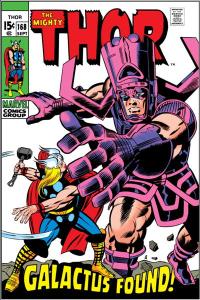 That does it, of course. Loki makes no further argument, and Odin zaps him out of there — leaving Don Blake free to pick up his abandoned cane, enter the hospital, and save Balder’s life. That done, he transforms back into Thor and hies himself home to Asgard, ready to begin his fateful journey in Thor #168 — which, unlike #167, I did buy.
That does it, of course. Loki makes no further argument, and Odin zaps him out of there — leaving Don Blake free to pick up his abandoned cane, enter the hospital, and save Balder’s life. That done, he transforms back into Thor and hies himself home to Asgard, ready to begin his fateful journey in Thor #168 — which, unlike #167, I did buy.
In “This World Renounced!”, Jack Kirby’s pencils had been inked by the same artist who’d been his regular embellisher on “Thor” ever since Journey into Mystery #116 (and on that title’s “Tales of Asgard” back-up feature since ten issues before that), having missed only Thor #143 (Bill Everett handled that one) over a four-year run. This issue, however, found a different inker listed in the credits box — George Klein, a veteran artist who, after being let go by DC Comics in 1968, had been kept busy by Marvel over the last year, mostly on issues of The Avengers and Daredevil. Klein’s inks would appear on the following issue of Thor, #169, as well; sadly, however, this would be his last credited work, for Marvel or any other comics publisher, due to his untimely death from cirrhosis of the liver earlier in the year.*
I’ll be honest and admit that I may have missed Coletta’s inks when I first read these two issues fifty years ago — probably because, though I still hadn’t read all that many issues of Thor by this time, I already associated Colletta’s “scratchiness” with Kirby’s vision of Asgard and the rest of the Thunder God’s milieu. (Also, at the time I was still unaware of Colletta’s penchant for occasionally erasing pencilled details to avoid having to finish them in ink.) Today, I’m better able to appreciate Klein’s work on Thor — he brought a clean, almost minimalist touch to Kirby’s pencils that, as others before me have noted, is somewhat reminiscent of Chic Stone — and wish he’d been able to do more.
“Galactus Found!” begins with Thor on the Odinship, launching off into deep space. As already noted, my twelve-year-old self didn’t seem to have missed much of anything, beyond the reason why Balder was being discharged from an Earth hospital with his head all bandaged up. But, I wouldn’t have time to worry about that (or any real reason to), once Balder’s Asgardian buddies, the Warriors Three, appeared on the scene:
Those newspaper headlines about trouble a’brewin’ in the Far East will turn out to be portentous, of course. First, though, the story rejoins Thor, already beginning to feel lonely aboard the Odinship (though you really can’t blame the guy):
It looks like Thor’s potentially-endless voyage is going to be over almost as soon as it’s begun — though, of course, both the cover and title of #168 had pretty much given that away from the get-go.
Back on earth, meanwhile, in “the Orient” — or more specifically, China — we see what all the consternation in the New York papers is about: the development by the Chinese military of a giant, massively-powerful, shoots-heat-rays-from-his-eyes artificial being they call the Thermal Man. Which, of course, they plan to send halfway around the world to attack the United States, because that’s the kind of thing that “the Reds” did back in the 1960s — in the pages of Marvel comics, anyway:
Actually, this use of the Chinese as out-and-out villains was pretty retrograde, even by 1969 standards. Earlier Marvel stories, particularly in the first half of the decade, had taken a pretty hard-line stance regarding America’s geopolitical rivals in the Cold War, with both the Soviet Union and the People’s Republic of China churning out super-powered menaces to the Free World such as Titanium Man, Crimson Dynamo, the Red Ghost, and Radioactive Man on a fairly regular basis. In more recent years, however — and in parallel with the growing American opposition to the Vietnam War — those kinds of characters and situations had appeared less frequently. The “Thermal Man” subplot that runs through Thor #168 and #169, finally taking center stage in #170, may best be seen as one last spasm of Marvel’s original Cold Warrior ethos, which would yield to more nuanced takes on East-West relations in the coming decade.
In the meantime, out in space, Thor has emerged from the Odinship to explore the mysterious, massive structure that has swallowed it whole:
Telling Thor that he has no desire for battle, and that the only reason that Thor has found him is because he wished to be found, Galactus releases a “Visi-Cloud”; this sends the God of Thunder into a trance-like state, so that he can see in his mind’s eye what the world-eater tells him, as the latter begins to narrate his history:
When I first read this story in July, 1969, I assumed that this “one being — called the Watcher” was, y’know, our Watcher — the guy who’d made his debut back in Fantastic Four #13, whose “Tales” had been running as a back-up feature in Silver Surfer, and who also — not so 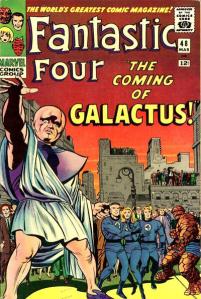 coincidentally — had turned up ahead of Galactus’ first advent on Earth** to warn us of his coming, in FF #48. And why wouldn’t it be that Watcher, aka Uatu? Sure, I knew that there was a whole race of these non-interfering cosmic spectators (thanks to the origin story that had appeared in Silver Surfer #1), and even that they all looked kinda alike (they were all bald, anyway). But Uatu was the only one of them who’d ever shown up in a Marvel comic outside that origin story, at least as far as I knew; and he also had a history with the Big G. For those reasons, I’m inclined to believe that Lee and Kirby did, indeed, mean for the Watcher we meet in Thor #168 and #169 to be Uatu. Later creators at Marvel, however, would find it necessary, or at least expedient, to establish that this was in fact another Watcher — Ecce, by name.
coincidentally — had turned up ahead of Galactus’ first advent on Earth** to warn us of his coming, in FF #48. And why wouldn’t it be that Watcher, aka Uatu? Sure, I knew that there was a whole race of these non-interfering cosmic spectators (thanks to the origin story that had appeared in Silver Surfer #1), and even that they all looked kinda alike (they were all bald, anyway). But Uatu was the only one of them who’d ever shown up in a Marvel comic outside that origin story, at least as far as I knew; and he also had a history with the Big G. For those reasons, I’m inclined to believe that Lee and Kirby did, indeed, mean for the Watcher we meet in Thor #168 and #169 to be Uatu. Later creators at Marvel, however, would find it necessary, or at least expedient, to establish that this was in fact another Watcher — Ecce, by name.
Galactus now pauses in his account to tell Thor that if he promises not to attack him, he’ll release him from the Visi-Haze (but I thought its purpose was to help Thor visualize the story’s events? Never mind.). Thor agrees, and Galactus allows him to wake up.
Meanwhile, back on Earth, Balder and the Warriors Three have made camp in Dr. Donald Blake’s not-so-swingin’ bachelor pad:
Fandral’s enjoyment of a TV Western has been interrupted by a breaking news bulletin — the Thermal Man, having successfully reached American shores, is now running amok in Manhattan. Apparently, every other superhero who calls New York home is out of town, so it’s up to our Asgardian stalwarts to save the day:
I’d become a fan of Fandral, Hogun, and Volstagg when I first met them (in Silver Surfer #4, of all places), and this scene just made me love these guys even more. Seriously, I couldn’t get enough of them. In years to come, I’d even be inclined to judge the Thor runs of various creative teams by how much they featured (or didn’t feature) the Warriors Three.***
Balder? Eh, he’s OK.
And now, we come at last to the comic that’s ostensibly the main topic of today’s post — Thor #169, which, like #168, I did manage to buy new off the stands. But before we get into the story, featuring the absolute, once-and-for-all, complete and definitive origin of Galactus (that is, until Marvel decided to expand and alter it fourteen years later), a word or two about the book’s cover.
Unlike most of the covers on most the comics Jack Kirby drew for Marvel, this cover’s not by him; rather, like that of #167, it’s the work of John Romita, who drew the central figure of Thor and, presumably, the outline of Galactus. (The images which form the background collage, on the other hand, are all by Kirby and Klein, having been pulled from this same issue’s interior art.)
Why did Romita end up doing two covers for Thor so close together mid-’69? There’s actually more than one answer to that question, and we’ll be considering them later in this post.
As Thor listens attentively, Galactus picks up his tale from where he’d left off in in #168, describing how the Watcher-later-to-be-known-as-Ecce moved through the plague ship, searching among the dead crew for any survivors:
Galactus’ narrative now moves further back in time, as he shares his memories of the world from which the ship, and he, originally came:
Taa, we learn, was a veritable paradise — and so advanced that the “thought-spheres” its inhabitants used for transportation were counted to be among “the simplest of its many miracles!”
In August, 1969, Galactus’ description of this Utopian world reminded me — as I’m sure it did others — of the account given by his own former herald, the Silver Surfer, of his lost homeworld, Zenn-La, in the first issue of the sky-rider’s series.
The gentleman who’s just returned from “the farthest reaches of the cosmos” with really bad news for his fellow Taa-ites will be our focal character for the rest of this flashback narrative (at least, until it returns to the Watcher); and while it’s never stated outright, we’re clearly meant to infer that this is the man who will someday, somehow, become Galactus. Lee’s script never gives him a name**** — but later chroniclers of Marvel Universe history will call him Galan, and so, for the sake of clarity, will we).
This deadly plague is currently ravaging life on planets throughout the galaxy — and all too soon, it reaches Taa as well:
Not even the miraculous thought-spheres can shield the people of Taa from the contagion of the plague — and so, Galan and the other few remaining survivors conceive a plan that won’t save their culture, but will at least allow it to go out in a literal blaze of glory:
The narrative has now circled back around to the moment when Ecce the Watcher observed the star-ship’s planetary crash landing; so Galactus goes on to tell us what happened following Ecce’s discovery of the craft’s lone survivor:
And with that one, rather abrupt act of All-Father Odin, Thor’s quest is done. In earlier issues, Odin seemed to have considered the very existence of Galactus to be a threat to Asgard, but now he’s changed his mind because… he feels kinda sorry for the Big G, I guess? Oh, well, I suppose the ways of the All-Knowing one are not ours to question.
Actually, I believe that my twelve-year-old self did question this conclusion to a plotline that had, after all, been brewing for the past ten issues. I thought that the origin of Galactus was interesting, but not entirely satisfying. It did make me more sympathetic to the planet-eater, but I didn’t see how it let him off the hook for, y’know, eating planets.
But, regardless of what I or any other fan might think, the creative team of Stan Lee and Jack Kirby was, as of this page, done with Galactus, the game-changing character they’d brought into the world three and a half years prior. (Done with him within the continuity of the main Marvel Universe, that is; the two creators would reunite in 1978 for a Silver Surfer graphic novel in which Galactus prominently appears). Lee and Kirby were moving on now, and taking their readers with them — back to Earth, and back to the mounting menace of the Thermal Man…
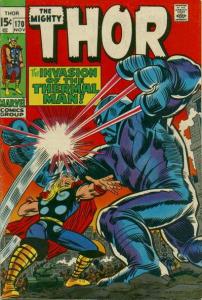 …about whom my younger self was apparently neither too much concerned, nor very interested (perhaps because I’d seen one too many of Kirby’s super-powerful, but personality-free robots in the past year or so?), since I didn’t buy Thor #170 when it came out in September. (No, not even for the Warriors Three. Hey, it’s not like they were even on the cover — which, by the way, was yet another John Romita job.)
…about whom my younger self was apparently neither too much concerned, nor very interested (perhaps because I’d seen one too many of Kirby’s super-powerful, but personality-free robots in the past year or so?), since I didn’t buy Thor #170 when it came out in September. (No, not even for the Warriors Three. Hey, it’s not like they were even on the cover — which, by the way, was yet another John Romita job.)
It’s possible, as it almost always is, that I just didn’t see this book on the racks. But even if that’s so, I seem to have lost interest in Thor for awhile around this time, as I wouldn’t buy another issue until #184, over a year later. This indifference coincided (as did my parallel feelings about most of Marvel’s other titles) with the company’s line-wide abandonment of continued stories (which obviously, and thankfully, turned out to be temporary; for the record, Thor was one of the first Marvel series to regress to the former policy, with a new three-parter — an Asgardian mini-epic involving Loki and Surtur — starting up as early as issue #175).
But I don’t want you to feel left hanging as regards the Thermal Man’s rampage across New York City — especially since that story’s going to be germane to the discussion occupying the next section of this post. So, here’s a brief synopsis of what goes down in “The Thunder God and the Thermal Man!” by Stan Lee, Jack Kirby, and Bill Everett.
Thor joins up with Balder and the Warriors Three, and they battle the T.M. inconclusively for nine pages or so, until the arrival of a missile that’s been sent over to the U.S. by the Chinese themselves — the “in-story” reason for this surprising development being that “the birds behind the Bamboo Curtain” have belatedly realized that if the Thermal Man turns out to be truly unstoppable, he could turn on them next; though one has to wonder if Lee, at least, had begun to have second thoughts about the “Red Menace” aspect of the storyline. (That supposition is given added weight, I think, by a line that he puts in the mouth of an American bomber pilot: “If we can team up for something like this — why can’t we cooperate on things like a lasting peace?“) This missile — which, by the way, conveniently “works on the principle of implosion“, so it doesn’t do any property damage — actually does lay the Thermal Man out, but only long enough to give our heroes a brief respite. Soon he’s up and at it again, and things momentarily look grim for Thor’s pals (Thor himself having stepped out for a page or two to aid the injured as Dr. Blake) — until Karnilla (remember her?) casts a spell which instantly brings Balder and the Warriors Three to her realm (and takes them out of the story).
Returning to the battle, the God of Thunder does now what he probably should have done in the first place — i.e., he calls upon the power of the storm:
(Yes, that’s a tidal wave that’s about to swamp a good hunk of NYC, but don’t worry — as readers were helpfully informed right on page 1, the city has been evacuated!)
And that’s a wrap, folks. Lee and Kirby’s nearly yearlong Galactus plotline sputters to a close, as the Thor title moves into its short run of largely unmemorable single-issue tales, beginning with #171’s return of the Wrecker (tales I wouldn’t read until sometime in the mid-Seventies, when I finally acquired them as part of my adolescent self’s obsessive quest for Thor back issues).
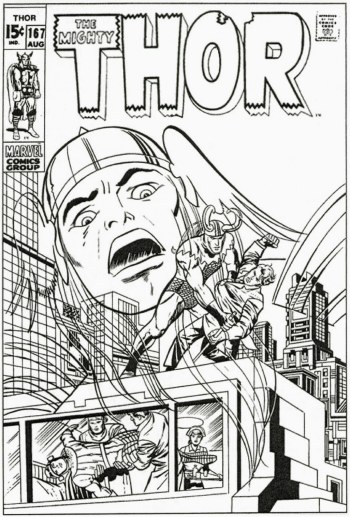 Earlier, I mentioned that that the appearance of three John Romita covers on Thor in fairly rapid succession could have more than one cause. The first of these, and the simplest, relates to the fact that Jack Kirby and his family moved house from Long Island to Southern California during the time these issues were in production. That means that, if Kirby drew a cover such as #167’s, which Lee (as the book’s editor) rejected for whatever reason — perhaps because he thought that it was too busy, or that the central figures of Loki and Don Blake weren’t large enough (as Nick Caputo suggests in this blog post), the artist may not have had time to re-draw it; whereas John Romita was in the Marvel offices every day.
Earlier, I mentioned that that the appearance of three John Romita covers on Thor in fairly rapid succession could have more than one cause. The first of these, and the simplest, relates to the fact that Jack Kirby and his family moved house from Long Island to Southern California during the time these issues were in production. That means that, if Kirby drew a cover such as #167’s, which Lee (as the book’s editor) rejected for whatever reason — perhaps because he thought that it was too busy, or that the central figures of Loki and Don Blake weren’t large enough (as Nick Caputo suggests in this blog post), the artist may not have had time to re-draw it; whereas John Romita was in the Marvel offices every day.
But there seem to have been more troubles involved with the production of Thor #167-170 than can be accounted for simply by the logistical challenges occasioned by Kirby’s cross-country move. We know this because multiple original art pages exist which obviously belong to the period when these books were produced — but which  also appear to tell a significantly different story. Among the scenes depicted by this artwork are ones in which Galactus shows Thor visions of Asgard, where Loki is being brought to trial before Odin; and of Earth, where Balder and the Warriors Three are fighting a rather different-looking iteration of the Thermal Man.
also appear to tell a significantly different story. Among the scenes depicted by this artwork are ones in which Galactus shows Thor visions of Asgard, where Loki is being brought to trial before Odin; and of Earth, where Balder and the Warriors Three are fighting a rather different-looking iteration of the Thermal Man.
In the 52nd issue of The Jack Kirby Collector, John Morrow lays out a prospective sequence of how Thor #168, #169, and #170 might have looked in their original form, with the unused pages worked in among those that made it into print. (I won’t reproduce that sequence here [or all the unpublished pages, for that matter], not so much for reasons of space or time, but rather because if you’re truly interested in this stuff and you don’t already own a copy of that magazine, you should follow the link above and go buy yourself a digital copy, right now.) Morrow may or may not be right in all of his guesses about what went where, but the exercise makes one thing very clear — if all of these “lost” pages had been included in the finished stories, there 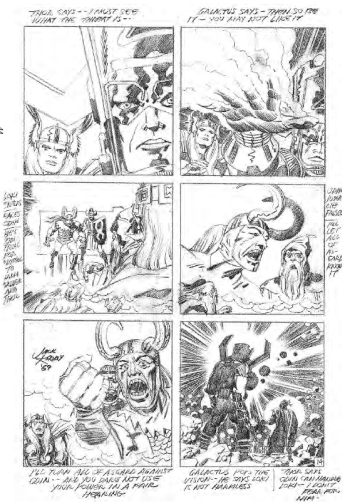 wouldn’t have been enough room for a number of the pages that were eventually published. So, what wouldn’t have been included in the original 20-pager that includes the greatest number of unused pages — the story that eventually became Thor #169? Surprisingly, it seems to be the sequence that runs from pages 6 through 13 of the published version — the Taa material, or, to put it another way, the origin of Galactus up to the point the Watcher enters the story.
wouldn’t have been enough room for a number of the pages that were eventually published. So, what wouldn’t have been included in the original 20-pager that includes the greatest number of unused pages — the story that eventually became Thor #169? Surprisingly, it seems to be the sequence that runs from pages 6 through 13 of the published version — the Taa material, or, to put it another way, the origin of Galactus up to the point the Watcher enters the story.
How is it possible that the issue of Thor that reveals the beginnings of Galactus wasn’t originally supposed to tell that story, or at least not all of it? One possibility is that the saga was originally supposed to run past #170. As Morrow notes in his article, Marvel’s new “no more continued stories” policy was instituted while this storyline was still in progress, so perhaps the Taa pages would have shown up later. The idea that they may have been drawn  later than most of the rest of #169 gains support from the fact that most of the inking on them is generally attributed to Bill Everett, who seems to have stepped in when Klein was no longer able to work.
later than most of the rest of #169 gains support from the fact that most of the inking on them is generally attributed to Bill Everett, who seems to have stepped in when Klein was no longer able to work.
But there’s also the possibility that those pages were drawn years earlier than the rest of the material in the issue. Morrow references a statement by comics writer and historian (and longtime Kirby associate) Mark Evanier that Kirby once told him “that he’d deleted a long sequence with The Watcher from an issue of Fantastic Four and later used it in Thor.” Of course, the Watcher doesn’t actually appear in the 8-page Taa sequence as we now have it, but perhaps he did originally. Kirby is also reputed to have begun work on an origin for Galactus’ former herald, the Silver Surfer, that he planned to use in FF, but ultimately put aside when he learned that Lee was doing his own origin for that character with John Buscema. Could Kirby’s Surfer origin have included material on Galactus’ backstory as well? At present, we have no way of 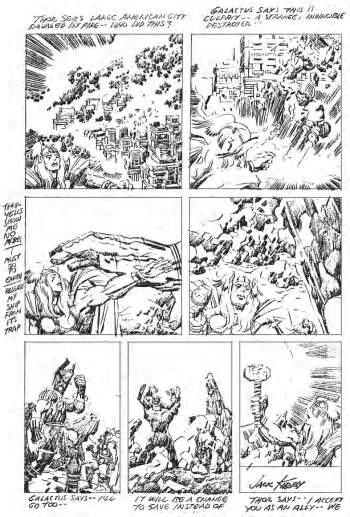 knowing. But if Kirby had indeed set those pages aside, he might have pulled them out to use in #169 after Lee requested changes in the story (which could have occurred after Klein had to leave the book).
knowing. But if Kirby had indeed set those pages aside, he might have pulled them out to use in #169 after Lee requested changes in the story (which could have occurred after Klein had to leave the book).
Because what we do know, without a doubt, is that the story that Jack Kirby had initially plotted for Thor #169, and even partially drawn, was very different from the one that saw print. There’s no clearer evidence of that than the original closing page of the issue, shown at right, in which Galactus decides to team up with Thor to save Earth from the Thermal Man. Morrow thinks that this could have been the single most important factor causing Lee to ask Kirby for major changes — that Lee balked at the radical notion of making the Big G a “good guy”, even for one storyline — and I agree that this seems very plausible.
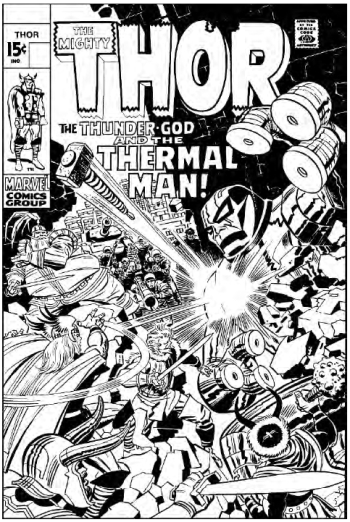 In any event, it’s clear that Lee made his request before Kirby had started drawing #170, or at least before he’d gotten very far with it, since no original art showing Thor and Galactus fighting Thermal Man together exists (and, just making an observation here, wouldn’t that have been an extremely lopsided and probably quite short fight?). The “reconstructed” #170 that Morrow presents in TJKC #52 is the same as the published version, with the exception of two pages that focus on the Loki-in-Asgard subplot that had already been cut from the two previous issues.
In any event, it’s clear that Lee made his request before Kirby had started drawing #170, or at least before he’d gotten very far with it, since no original art showing Thor and Galactus fighting Thermal Man together exists (and, just making an observation here, wouldn’t that have been an extremely lopsided and probably quite short fight?). The “reconstructed” #170 that Morrow presents in TJKC #52 is the same as the published version, with the exception of two pages that focus on the Loki-in-Asgard subplot that had already been cut from the two previous issues.
We do have an unused Kirby cover for #170, as shown at left. It would seem that it was drawn after the Thor-Galactus team-up was nixed, since Galactus doesn’t appear on it (granted, it would have been pretty hard to squeeze him in); also, the appearance of the Thermal Man accords with the way he looks in the published #168 and #169, rather than with the somewhat different design evident in the unused pages drawn for #169, arguing for a late date of composition. There is one odd thing about this cover, however, that suggests that vestiges of the original version of the storyline were still extant when Kirby drew it — in the cover’s lower left corner, we see an Asgardian wearing a horned helmet (Heimdall, maybe?), but no such character appears in the published story itself. Of course, that’s just one more mystery to add to a long list of such associated with this storyline — mysteries that may never be completely solved unless new evidence come to hand, but which remain fascinating to contemplate.
 Whatever Jack Kirby had planned for Thor #169, the story he ended up telling in that issue, with Stan Lee, was the origin of Galactus. And, as already mentioned, that story stood as the one and only, complete origin of the Devourer of Worlds… until 1983, when some folks at Marvel decided that it wasn’t quite enough. This wasn’t immediately apparent from the comic’s Bob Layton-drawn cover, whose copy implied that the book was nothing more than a re-presentation of existing material by Lee and Kirby, but Super-Villain Classics #1 was in fact an expansion and re-imagining of the Big G’s backstory.
Whatever Jack Kirby had planned for Thor #169, the story he ended up telling in that issue, with Stan Lee, was the origin of Galactus. And, as already mentioned, that story stood as the one and only, complete origin of the Devourer of Worlds… until 1983, when some folks at Marvel decided that it wasn’t quite enough. This wasn’t immediately apparent from the comic’s Bob Layton-drawn cover, whose copy implied that the book was nothing more than a re-presentation of existing material by Lee and Kirby, but Super-Villain Classics #1 was in fact an expansion and re-imagining of the Big G’s backstory.
Behind the cover, the first page’s credit box acknowledged not only primary authors Lee and Kirby, but also inkers Coletta and Klein — and then added a credit for “Supplemental Material” by Mark Gruenwald, John Byrne, Ron Wilson, and Jack Abel. Most of the book is, in fact, taken verbatim from the relevant issues of Thor — the dialogue has been relettered, but it’s still Lee’s dialogue — but a handful of panels do contain brand-new copy which, in effect, changes everything. Here’s an early, and prime, example:
In the original story, Galan emerged from his spacecraft to describe a “creeping plague!” Now, with the addition of one word balloon and some judicious editing of others, the crisis has been transformed from a biological to a cosmological one: “The molecules — the very atoms of our universe — are changing!” It’s not just life throughout the universe that’s doomed — it’s the entire physical universe itself.
And as the crisis continues, it’s not some virus or other infection that fells the people of Taa, but the deadly radiation that’s being released as the universe breaks down:
As before, Galan and the other remaining survivors plan to use a starship to immolate themselves — but this time, they intend to fly into the “terminal point of the universe”, rather than something so mundane as “the largest sun in all the world”.
In this version, rather than careening wildly through space, the radiation-blasted ship sails straight into “the fiery cauldron of the cosmos”, as was the Taa-ites’ intent…
…which, in turn, leads to the comic’s single page of all-new art and story — almost certainly pencilled, and probably inked, by Byrne, with script by either Byrne or Gruenwald:
As of this page, Galactus is no longer merely the sole survivor of an interstellar plague, but rather the last living remnant of a collapsed universe — the only link between our present cosmos, and the one which came before.
In many ways, it’s a superior origin story to the one it supplants. Its exponentially greater scope better serves the standard way of framing Galactus that had emerged in the years between 1969 and 1983 — the portrayal of him as a sort of cosmic constant, a fundamental force of the universe that couldn’t be judged by conventional standards of good and evil. This framing was probably unavoidable, for otherwise there’s no logical reason why the whole Marvel Universe wouldn’t be constantly trying to find and destroy Galactus with the same sense of urgency that Odin had demonstrated in Lee and Kirby’s Thor epic (up until page 18 of #169, anyway).
But that aspect of the revised origin has always seemed to me to be a weakness, at least as much as it is a strength. The problem, as I see it, is set forth clearly in Galactus’ final words on the last page of Super-Villain Classics #1 (a Kirby-Coletta splash originally from Thor #160, but featuring all-new dialogue):
“…It is my destiny to one day give back to the universe — infinitely more than I have ever taken from it.” That, in a nutshell, is the only justifiable reason for the rest of the Marvel Universe to give the Big G a pass for all the untold billions of lives he’s taken over the course of his existence. But exactly how is Galactus going “to one day give back” — and, perhaps more importantly, when? That’s always bugged me; and, for the most part, I don’t think that Marvel’s creators have provided very convincing answers over the past thirty-six years.
My favorite post-Kirby Galactus stories have tended to be the ones that push against the standard interpretation in one way or another; ones such as a 2005 Fantastic Four storyline, written by Mark Waid and drawn by Mike Wieringo, in which the FF temporarily put an end to the Devourer’s devouring by regressing him back to his original, mortal self of Galan — only to discover that the tragic, noble last survivor of a doomed universe is actually kind of an asshole (panels below from FF #523 [Apr., 2005]):
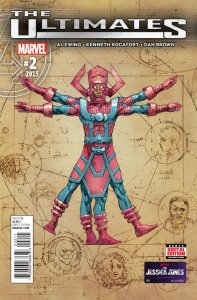 And then, of course, there’s the all too short, but nonetheless sweet career of Galactus the Lifebringer — a Galactus who actually is a good guy, much like Jack Kirby seems to have imagined fifty years ago. This take on Galactus, which comes to us courtesy of writer Al Ewing and artist Kenneth Rocafort in The Ultimates (2015), gets its start when the Black Panther, Captain Marvel, and their cohorts in the titular team decide that if Galactus’ destiny really is to one day give back to the universe more than he’s taken from it, etc., well, then, maybe destiny needs a little push. And so, that’s what we get in Ultimates #2 (Feb., 2016), as the team first forces the Big G to re-enter his incubator, then floods that sucker with cosmic energy — so that Galactus’ evolution can finally be completed, and he can at last become his truest, bestest self. And it works! Galactus emerges as a being whose purpose is to engender or restore life, rather than to consume it — the Lifebringer, rather than the Devourer, of Worlds. He gets started in his new role by bringing life back to Archeopia, the first world he ever consumed (an event first chronicled by Lee and Kirby, in Thor #162):
And then, of course, there’s the all too short, but nonetheless sweet career of Galactus the Lifebringer — a Galactus who actually is a good guy, much like Jack Kirby seems to have imagined fifty years ago. This take on Galactus, which comes to us courtesy of writer Al Ewing and artist Kenneth Rocafort in The Ultimates (2015), gets its start when the Black Panther, Captain Marvel, and their cohorts in the titular team decide that if Galactus’ destiny really is to one day give back to the universe more than he’s taken from it, etc., well, then, maybe destiny needs a little push. And so, that’s what we get in Ultimates #2 (Feb., 2016), as the team first forces the Big G to re-enter his incubator, then floods that sucker with cosmic energy — so that Galactus’ evolution can finally be completed, and he can at last become his truest, bestest self. And it works! Galactus emerges as a being whose purpose is to engender or restore life, rather than to consume it — the Lifebringer, rather than the Devourer, of Worlds. He gets started in his new role by bringing life back to Archeopia, the first world he ever consumed (an event first chronicled by Lee and Kirby, in Thor #162):
I never expected Galactus the Lifebringer to hang around forever — obviously, Galactus the Devourer is simply too well-established and important a fixture in the Marvel Universe to ever be dispensed with completely — but I had hoped Marvel would allow him a run of more than just a couple of years. Ah, well, that’s the way the cosmos goes, I guess. Lifebringer, we hardly knew ye.
But I’d like to end this post not by remembering good Galactus stories of relatively recent vintage, but rather by reflecting on one that never was — Jack Kirby’s last Galactus story from his most important period at Marvel, planned for Thor in 1969 but never fully brought to fruition. Perhaps it would have been better than the story that actually ran, perhaps not — but I regret that we’ll never have the opportunity to find out.
UPDATE, 8/3/19: Many thanks to Ben Herman for pointing out that in my initial version of this post, I’d forgotten to note that the actual final Galactus story by the Lee and Kirby team was 1978’s Silver Surfer graphic novel. (I guess maybe I wanted to forget that one.)
*Although George Klein is the only inker officially credited for these two issues, several reliable sources, including the Grand Comics Database, indicate that several pages of #169 were actually finished by Bill Everett. This (presumably) last-minute pinch-hitting by Everett may have been due to Klein’s health problems, or to the other problems related to this storyline that are discussed elsewhere in this post, or perhaps both.
The month after Klein’s last Marvel work appeared, the following notice — probably the first comics-related obituary I’d ever seen — ran at the beginning of the Bullpen Bulletins column in every Marvel comic:
For more on George Klein’s life and career, I refer you to this fine article by my friend Ben Herman, posted on the occasion of the fiftieth anniversary of the artist’s death back in May. (Full disclosure: Ben says some nice things about this blog in his piece. But please don’t hold that against him.)
**In modern times, that is. A later story would reveal that Galactus had attempted to consume the Earth at least once before, back in the 16th Century, only to be repulsed by Leonardo da Vinci and the Brotherhood of the Shield.
***For the record, I happen to think that Jason Aaron’s soon-to-conclude tenure writing the God of Thunder is one of the three best runs the character’s ever had (right behind Lee & Kirby’s and Walt Simonson’s). I’m terribly sorry to see him go. But if I was going to complain about anything in his run, it would have to be that it didn’t have enough Fandral and Hogun. (Aaron definitely did right by Volstagg, though.)
****Margin notes on one of Kirby’s original art pages, however, suggest that the artist-author meant for the character to be called “Nirak”, as reported in The Jack Kirby Collector #52.
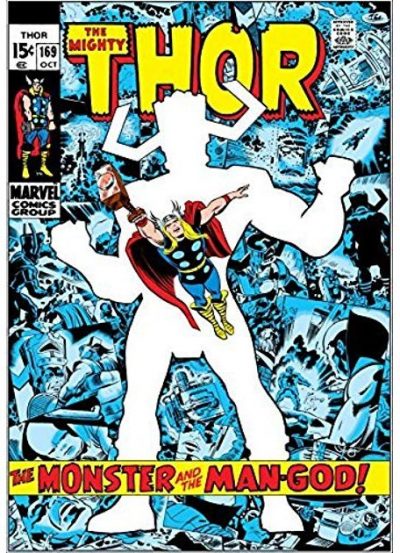

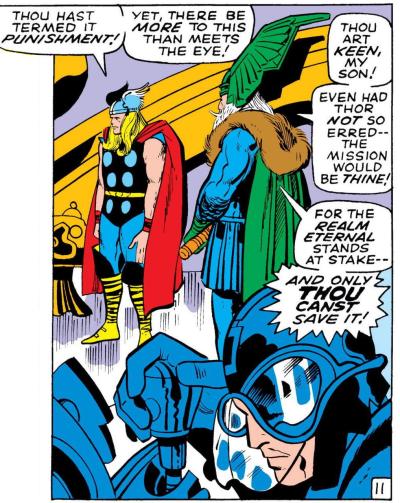
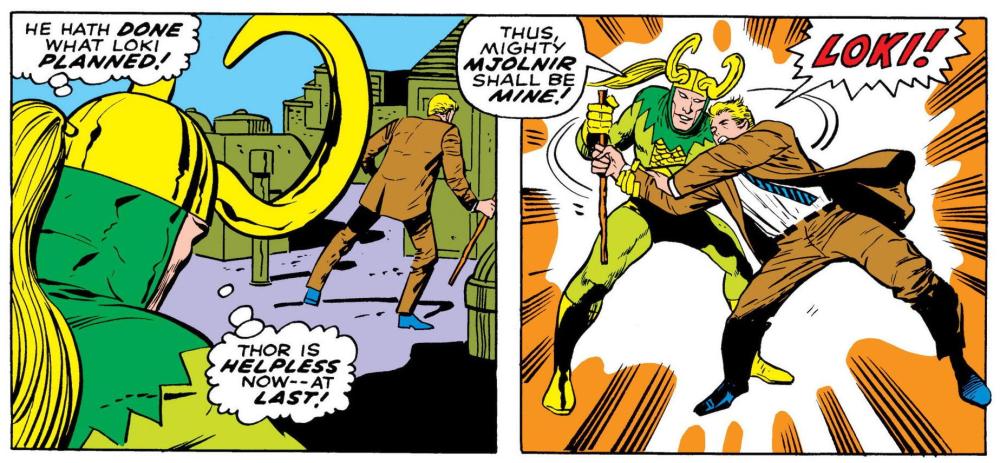
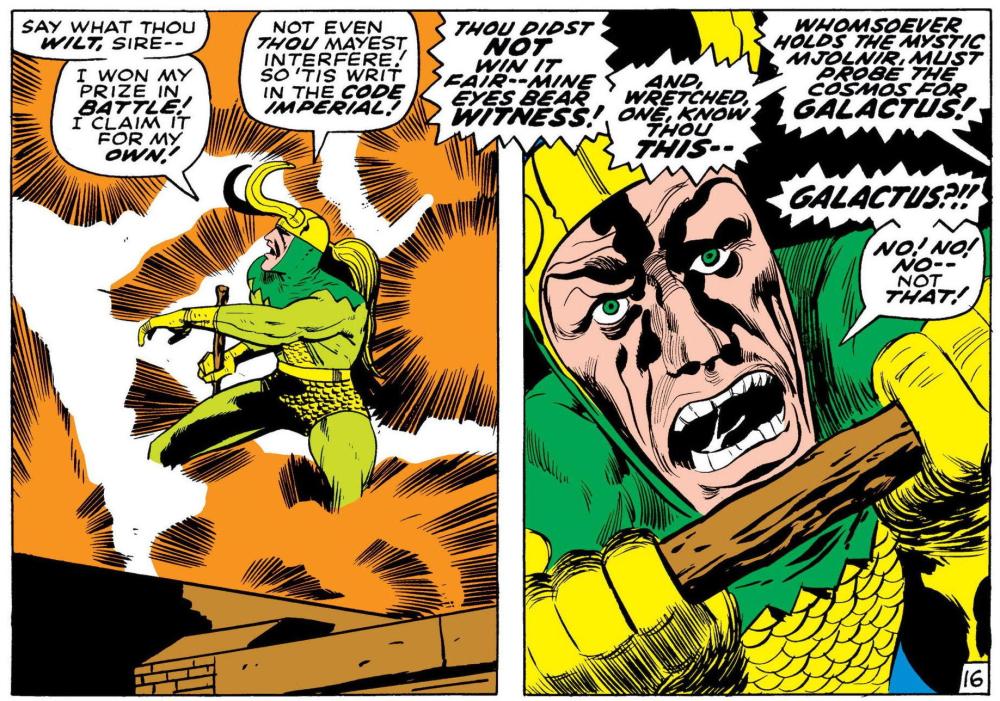
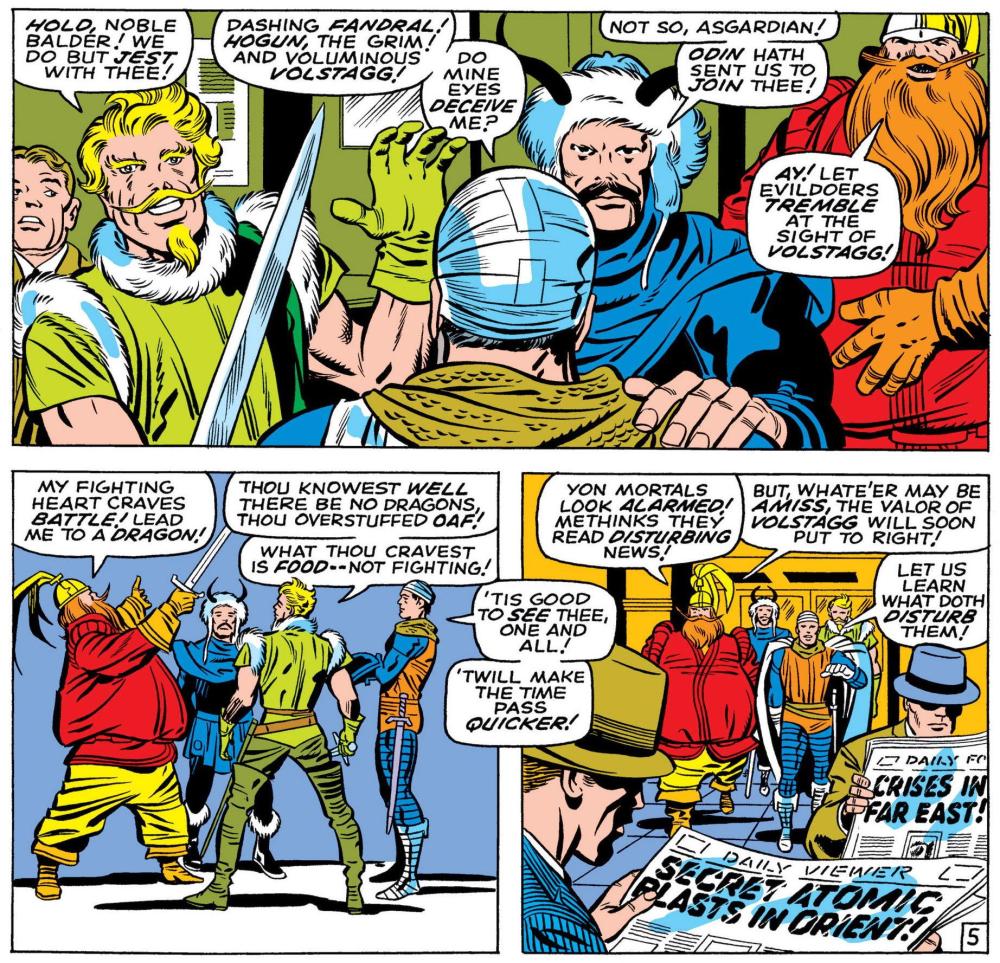


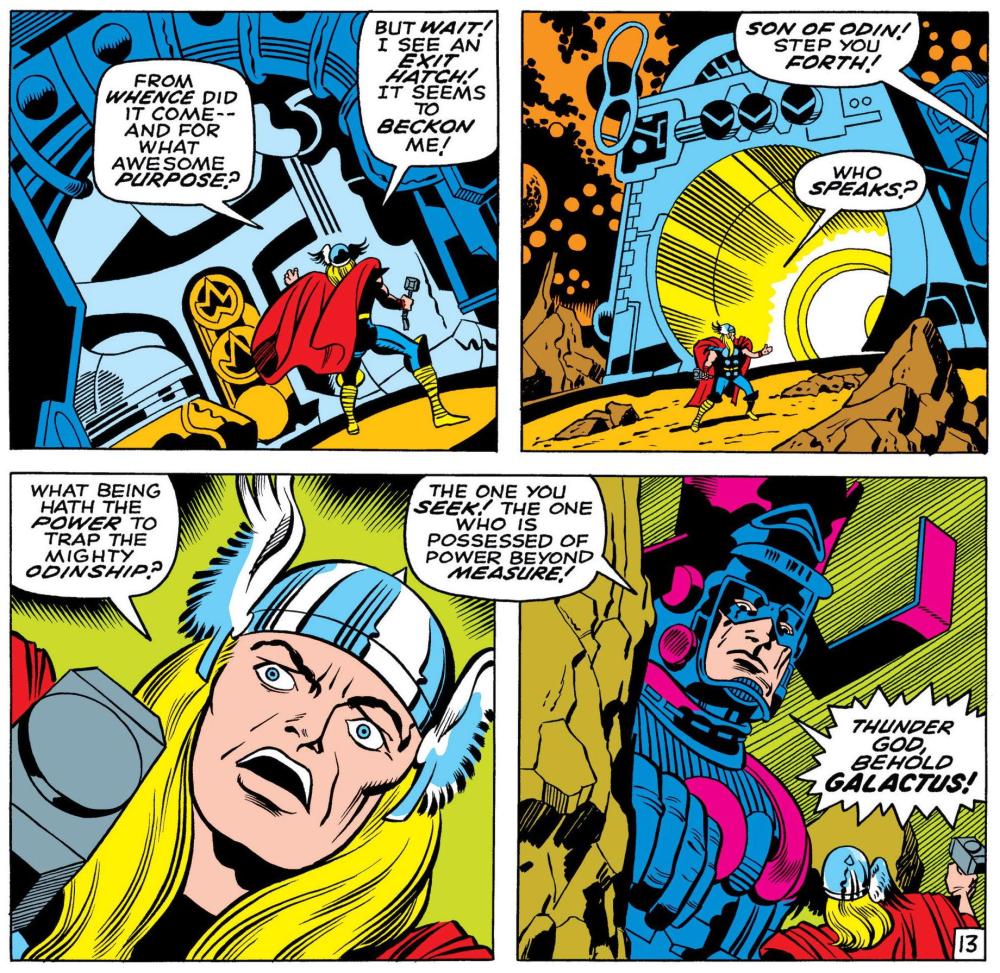
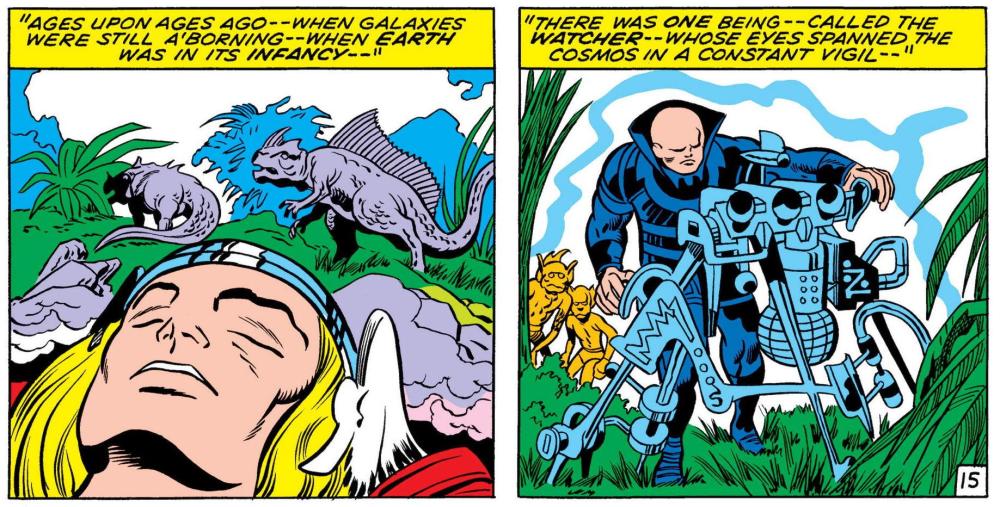

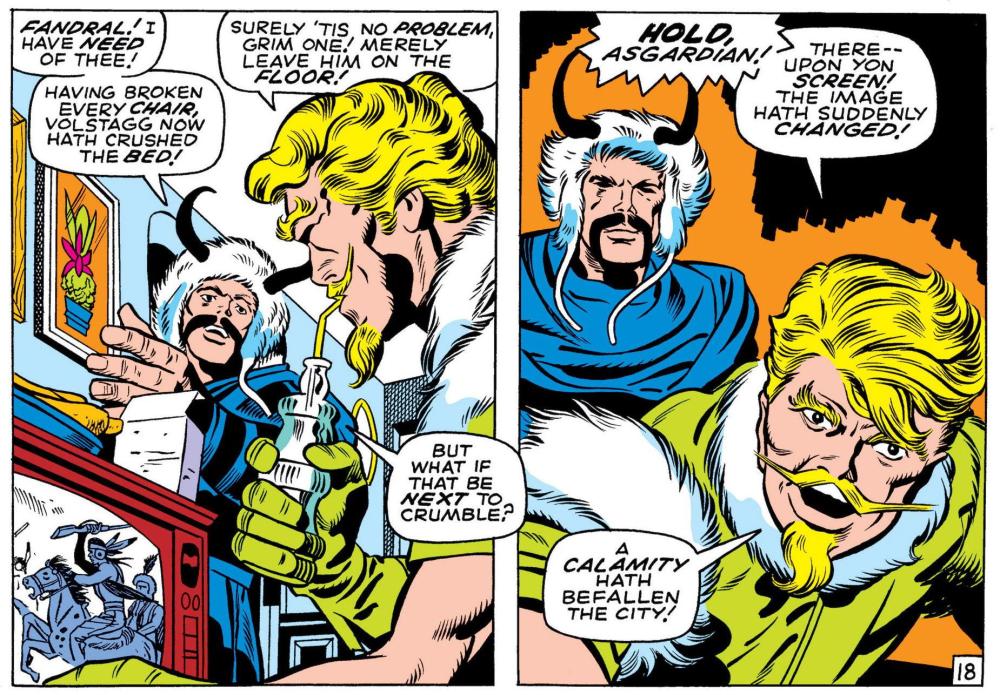

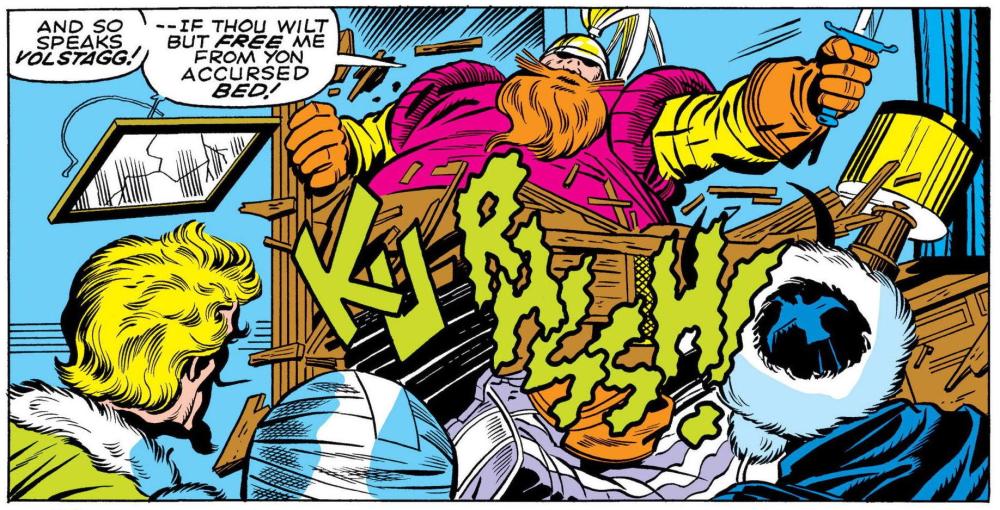

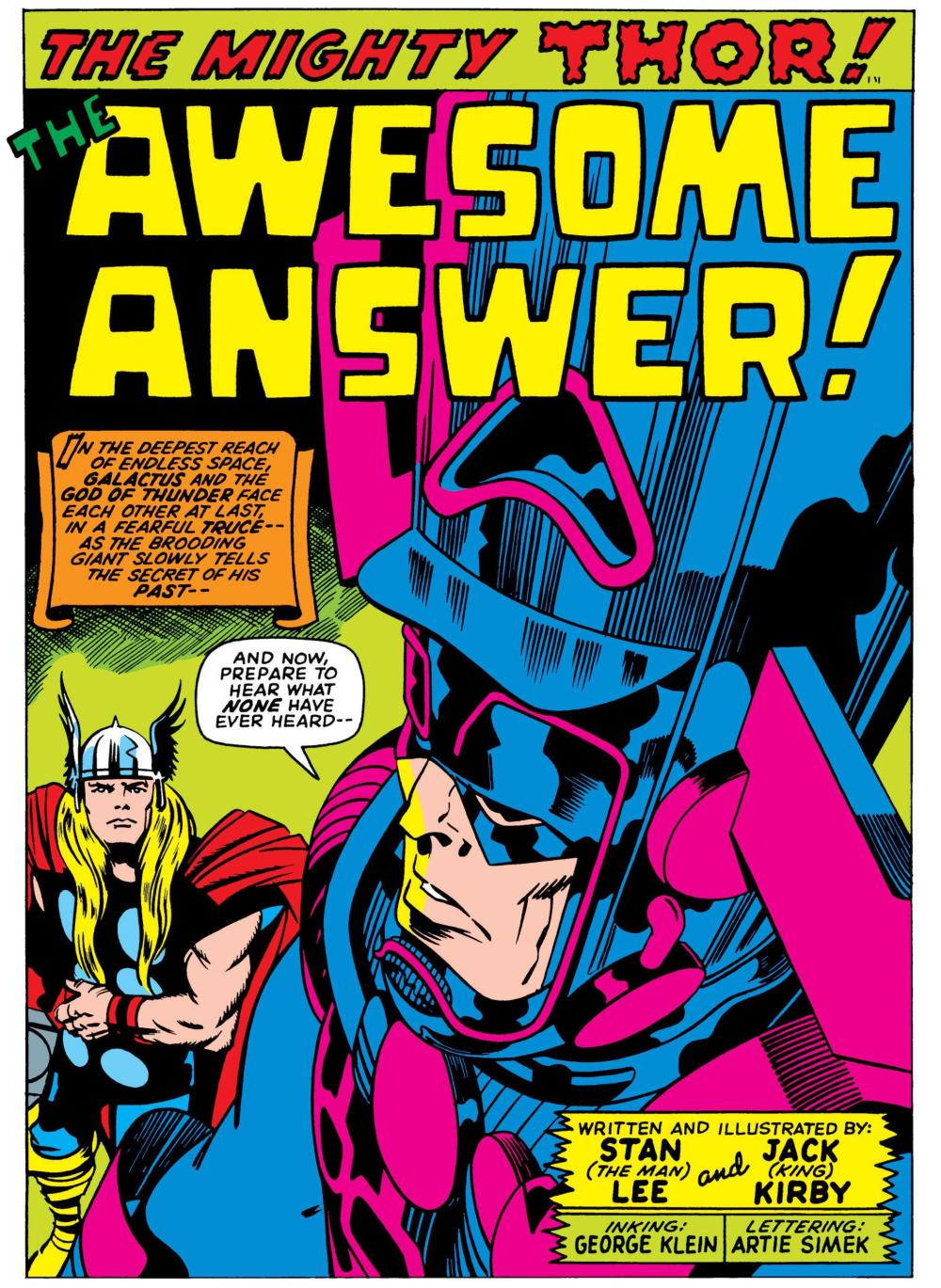

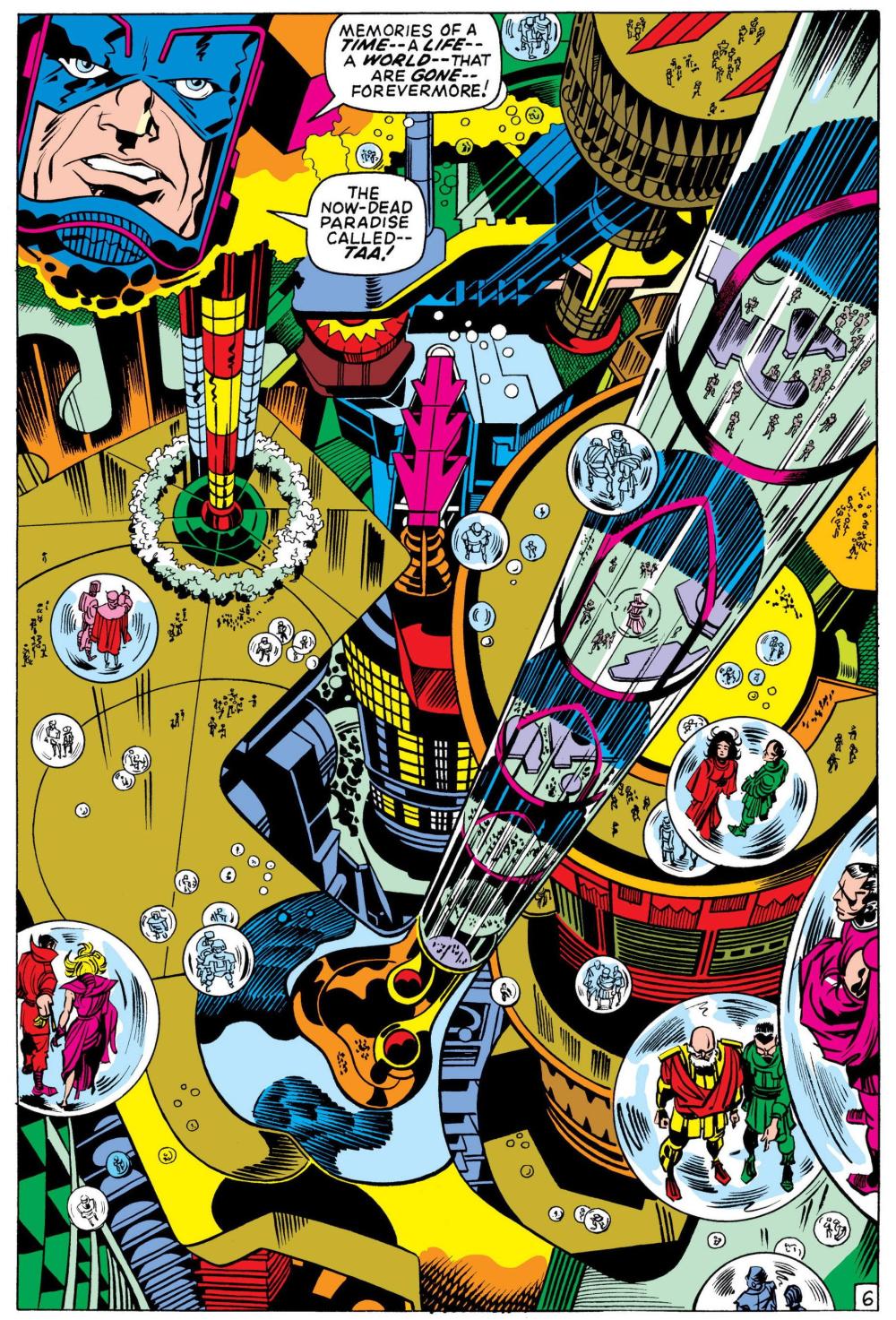
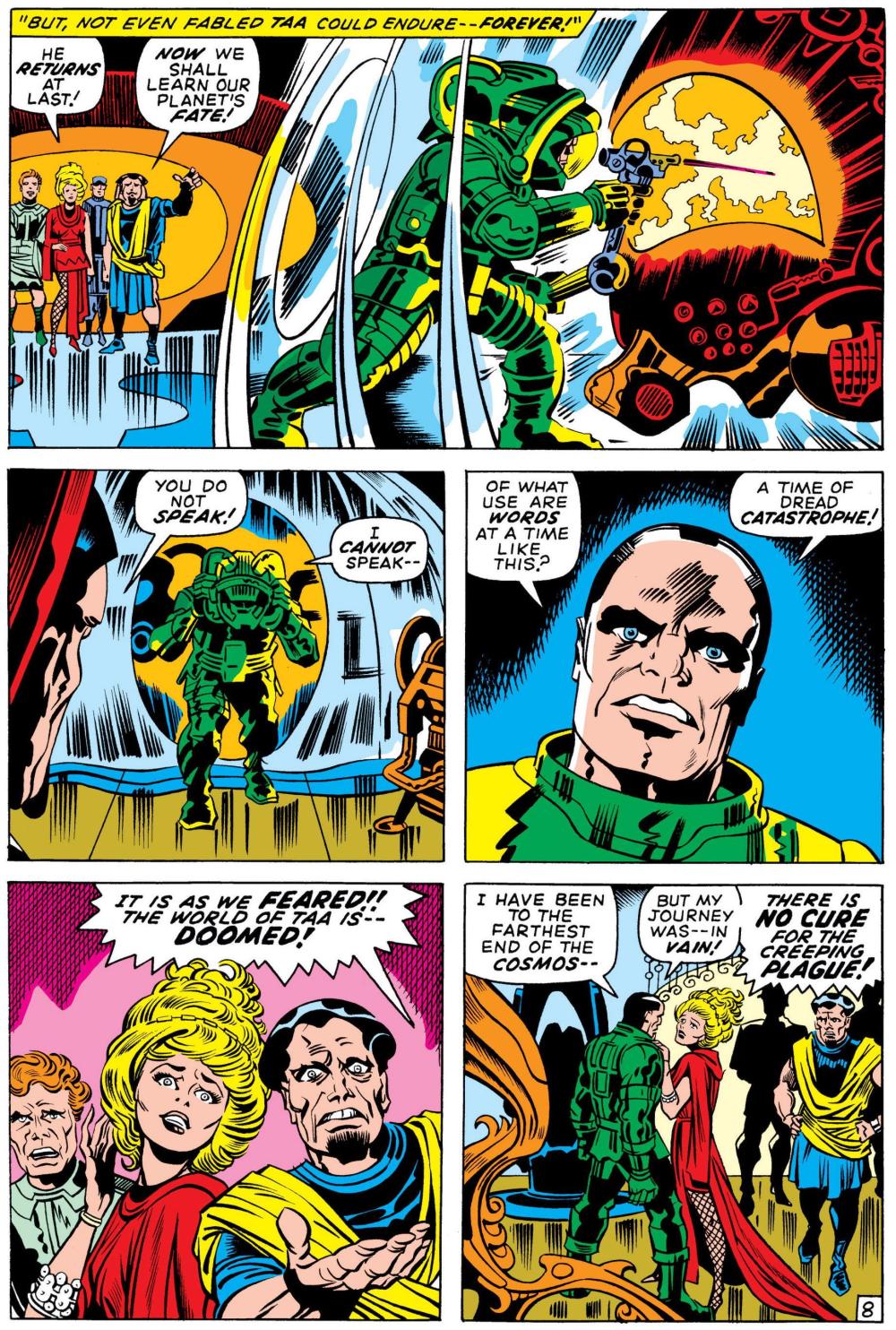
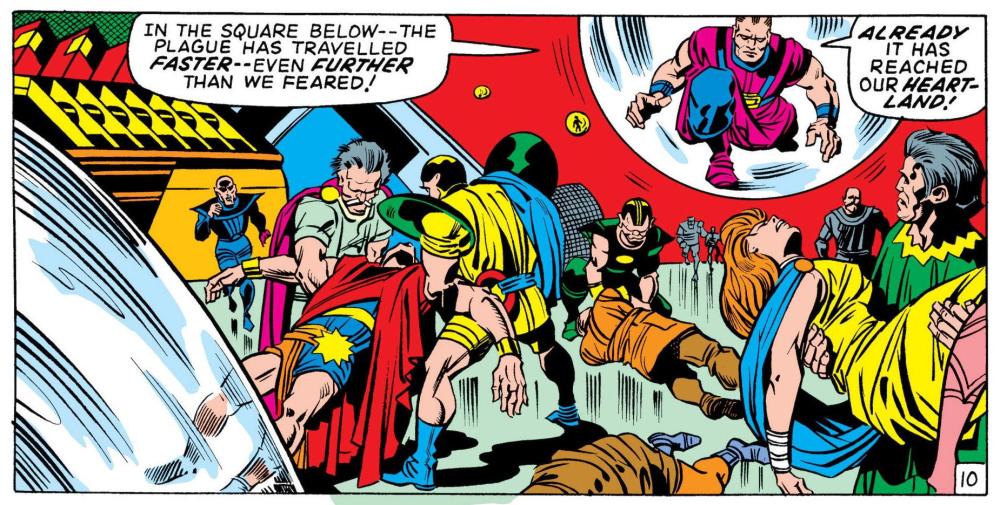

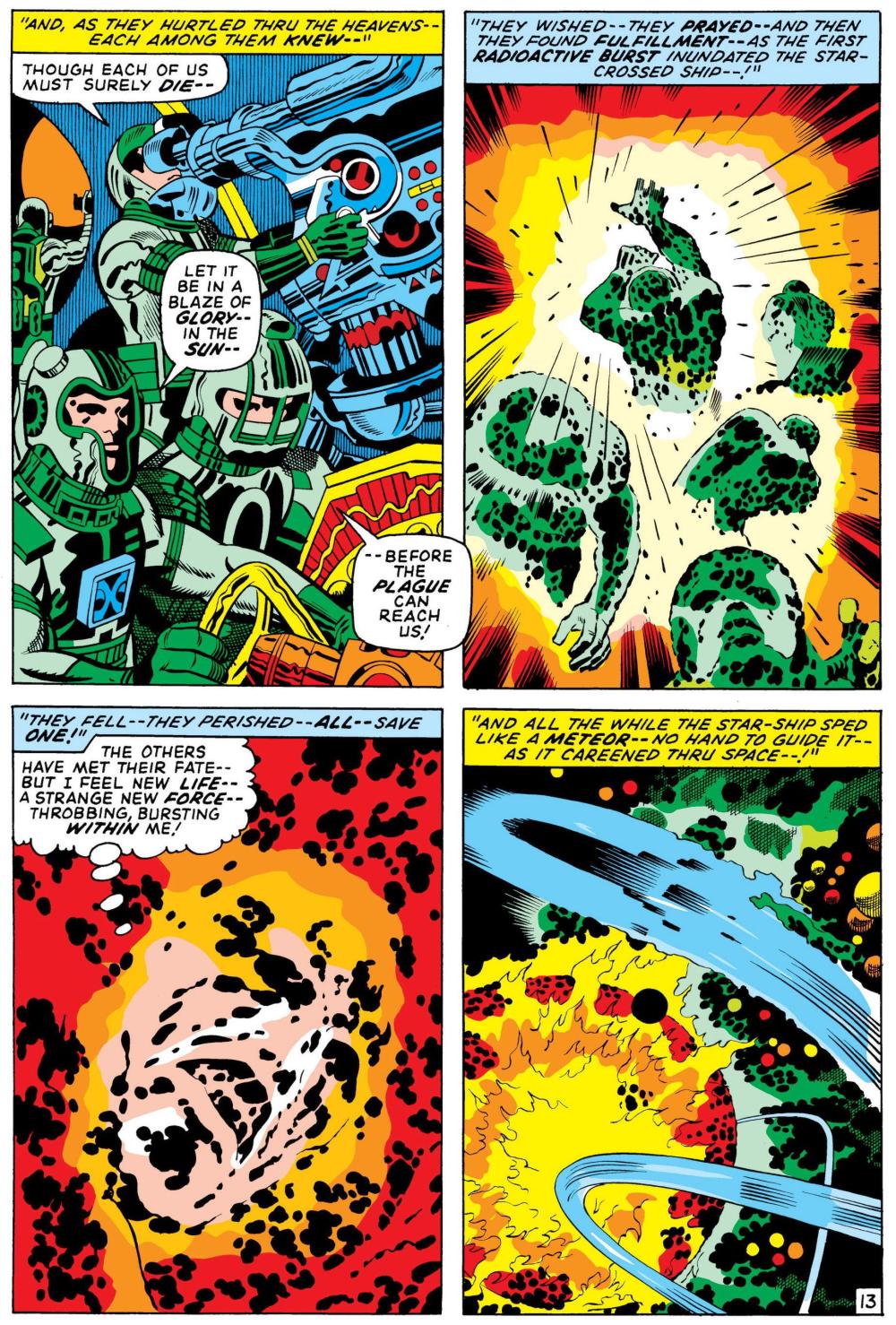
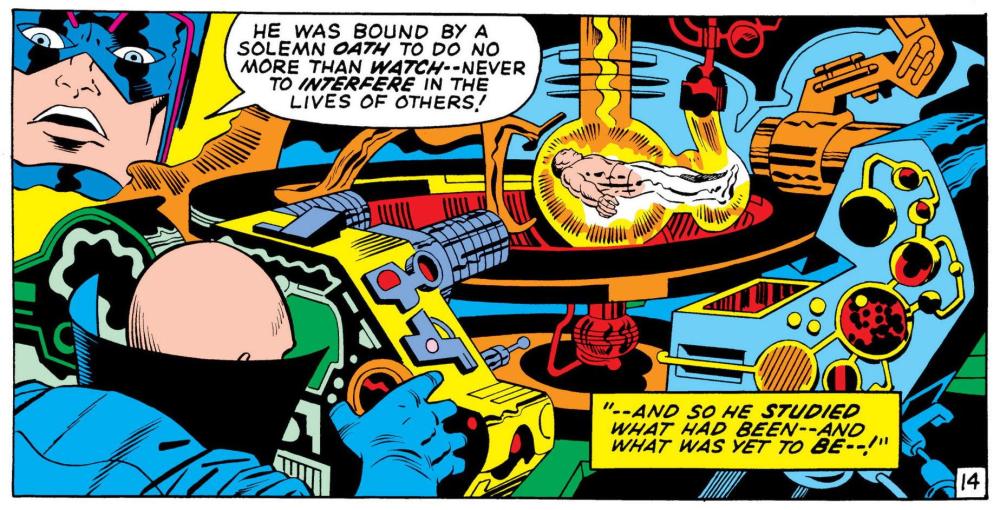



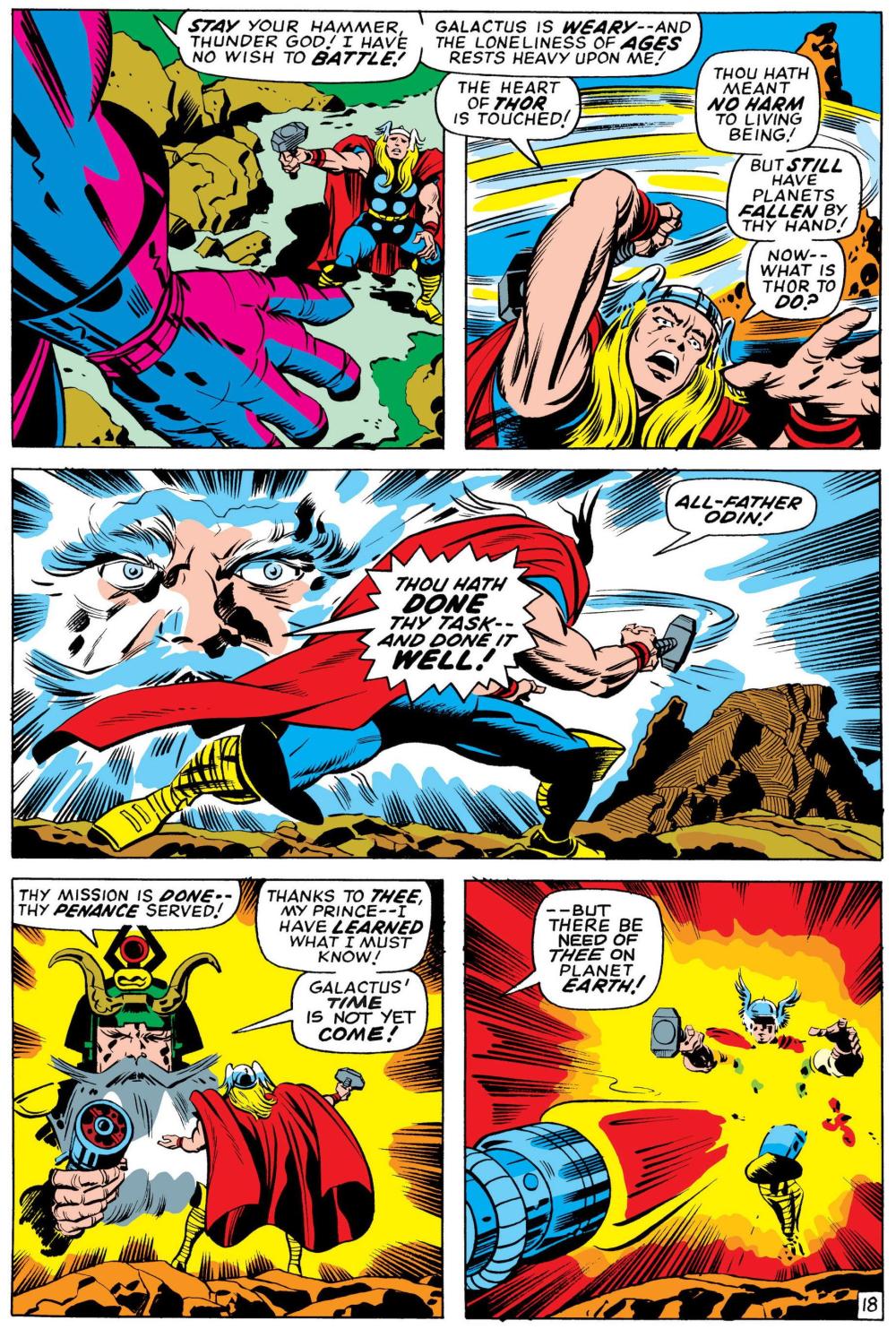

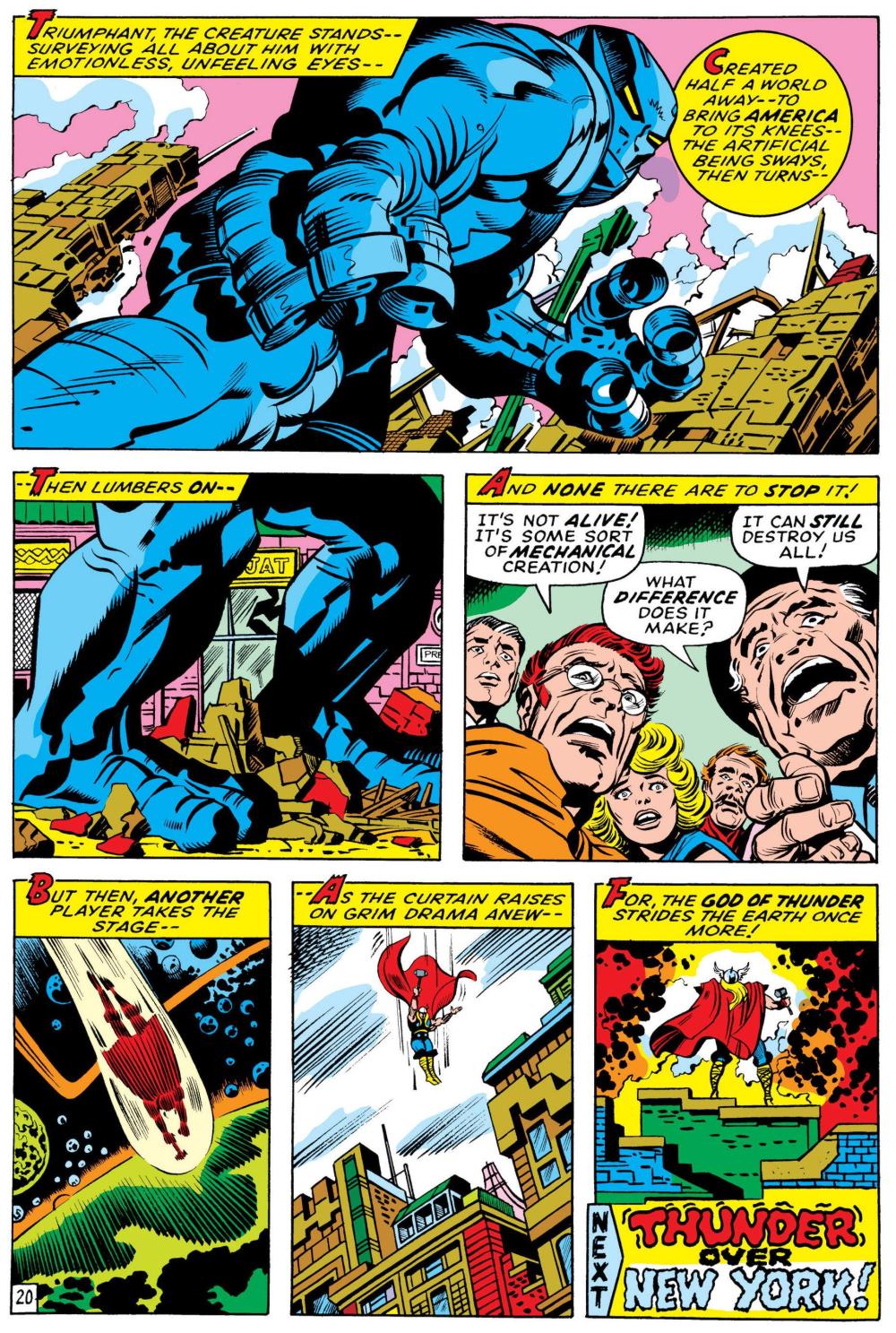
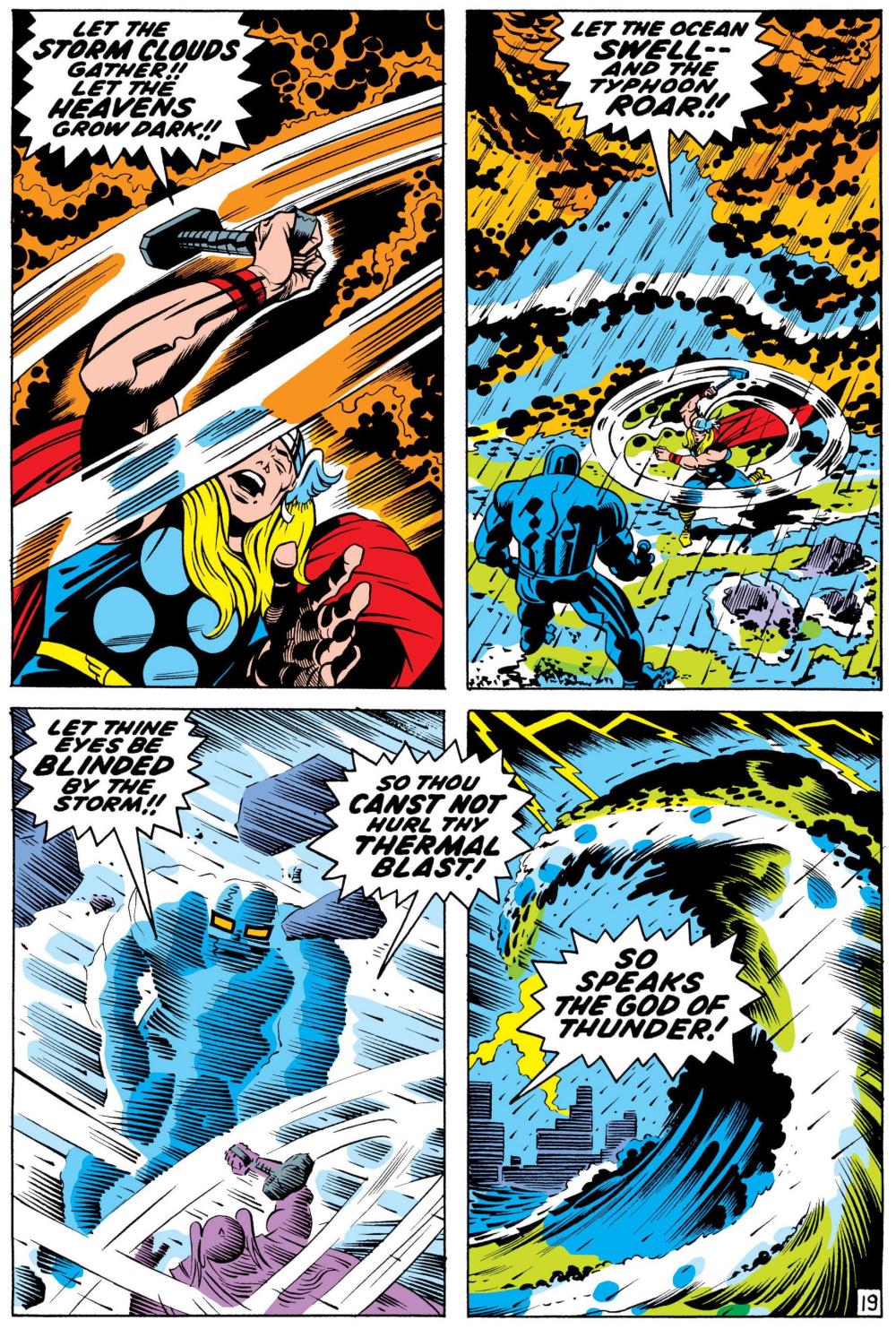
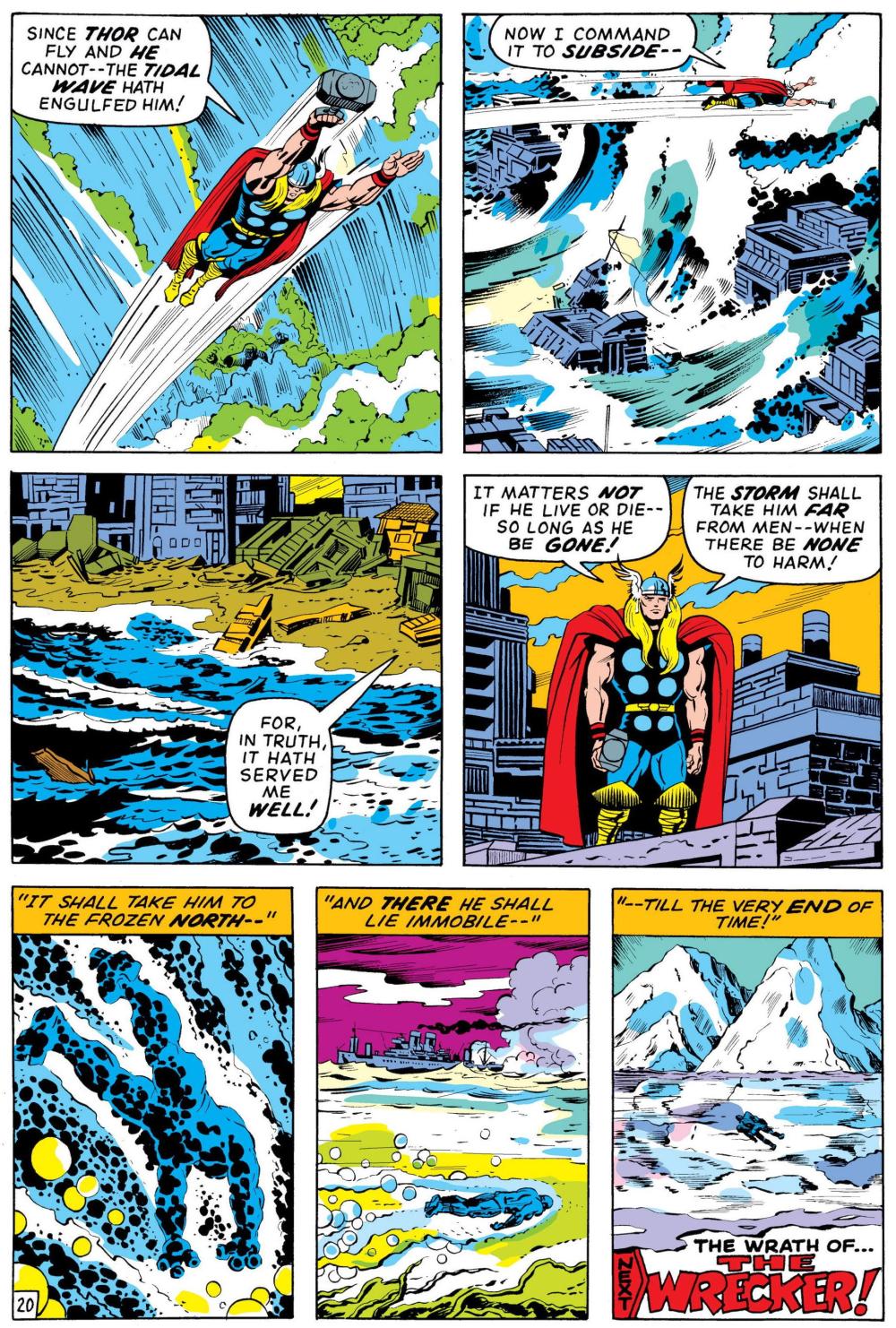
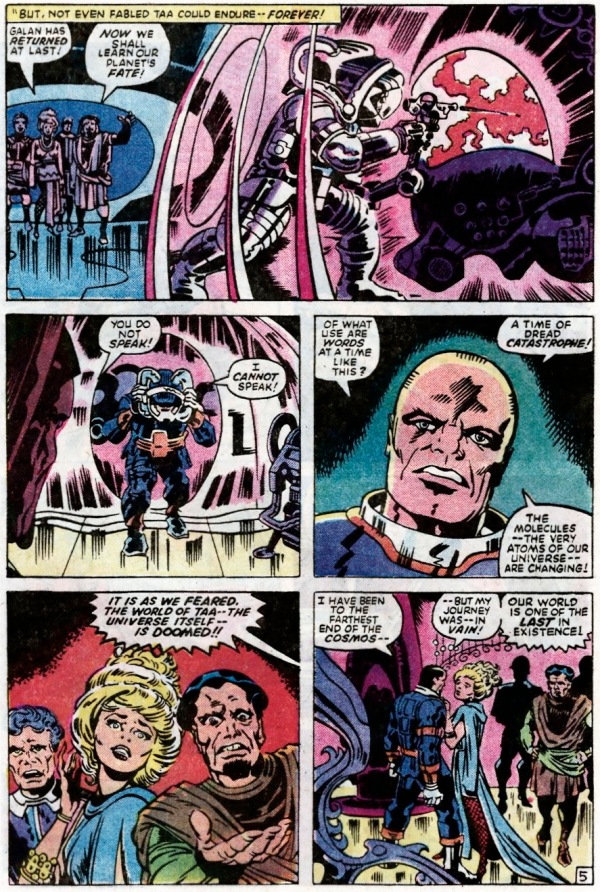
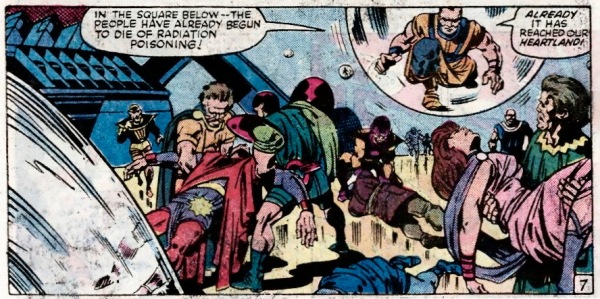

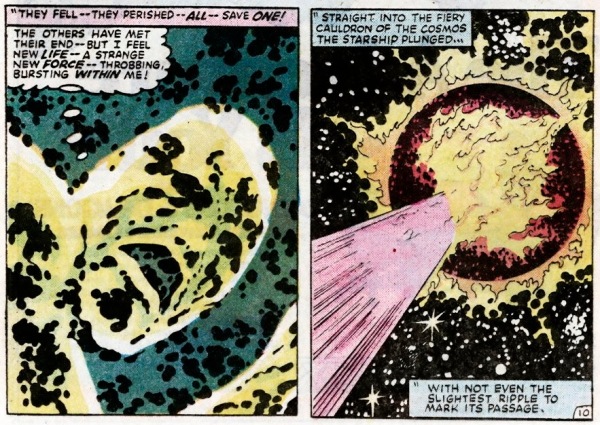

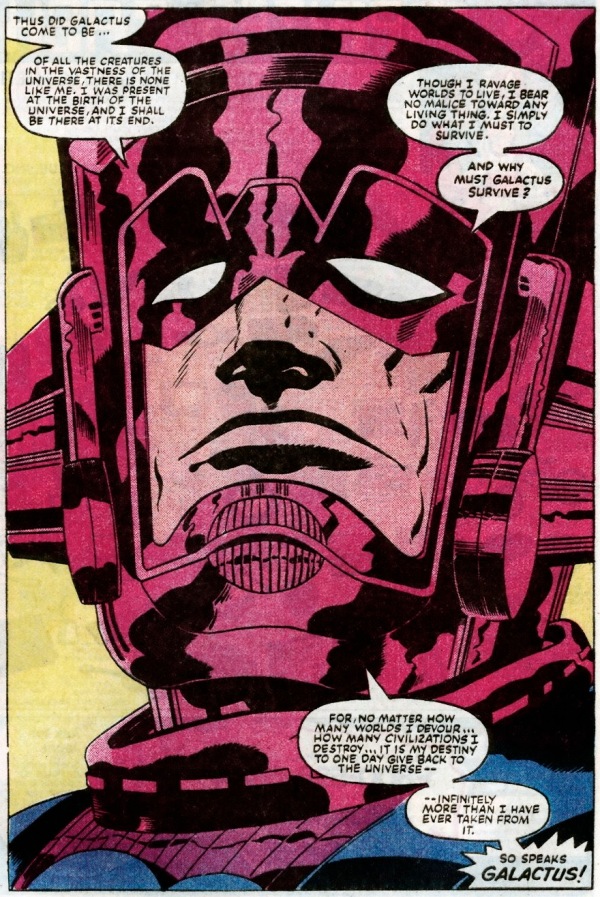
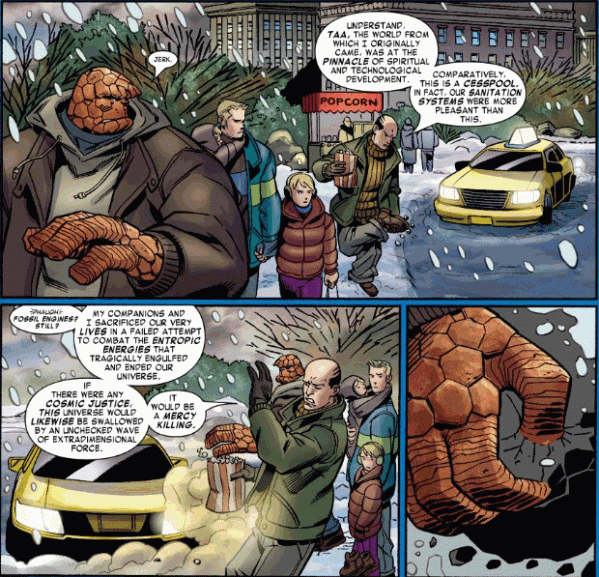
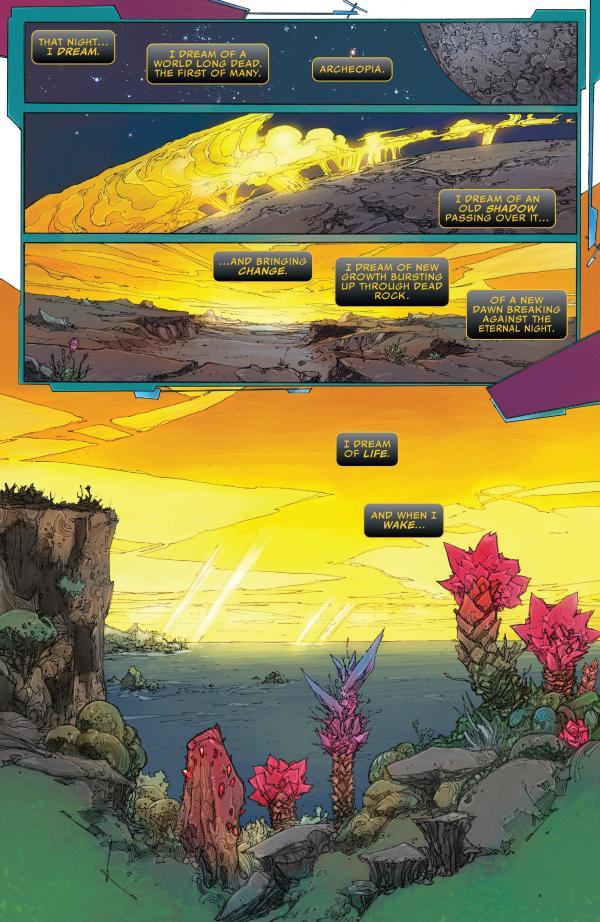
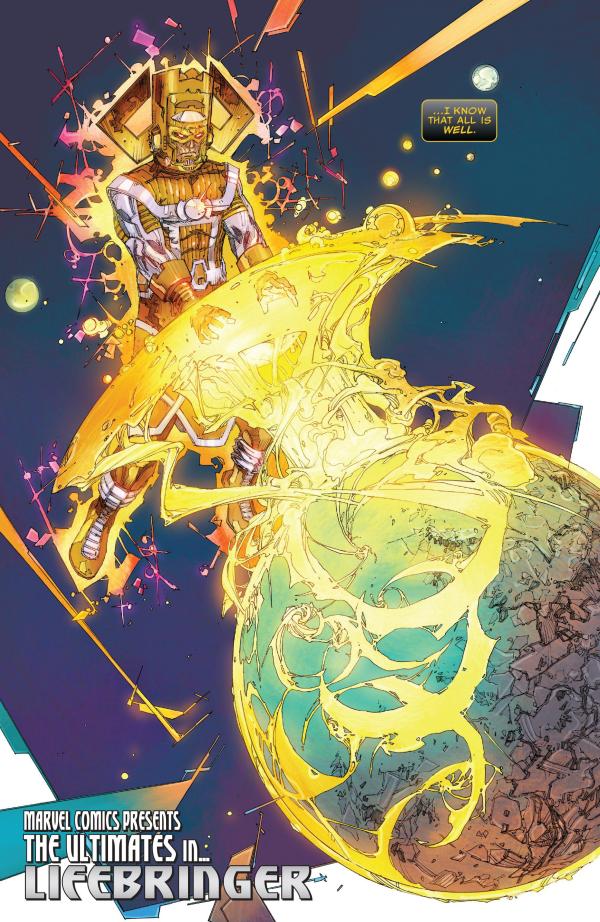
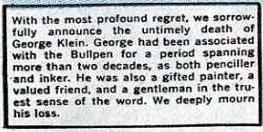
The line about Galactus giving more than he will take is probably from Byrne, referencing his soon-to-be-completed LAST GALACTUS STORY (which he started in the 80s in EPIC ILLUSTRATED).
Byrne has mentioned that at the end of the current universe, he’ll crack open his armor and unleash all the energies he’s collected, creating the new Big Bang for the next universe.
LikeLiked by 2 people
jmhanzo, I’m sure you’re right about that speech being a reflection of Byrne’s notion, which would have gotten fully explored in “The Last Galactus Story” had said story ever been completed. I have to say that I’m still not convinced that it lets the Big G off the hook for all those billions of lives he’s consumed in this universe, but that’s just me. Regardless, I’m sorry that it appears we won’t get to see Byrne finish his story after all, per https://insidepulse.com/2019/08/01/idw-executives-weigh-in-on-report-on-john-byrne-interview-about-last-galactus-story-marvel/ . I was looking forward to it.
LikeLike
Looking at the last panels of Thor #169, I couldn’t help but think “None of them knew about global warming yet”.
LikeLiked by 1 person
Besides not wanting Galactus to be a good guy, another reason Stan might have balkee at Kirby’s original story is that the right with the Thermal Man next issue would be over a lot faster with Galactus involved.
LikeLike
Whoops, you made the same observation in your post. I need to start reading all the way through before I post a comment.
LikeLike